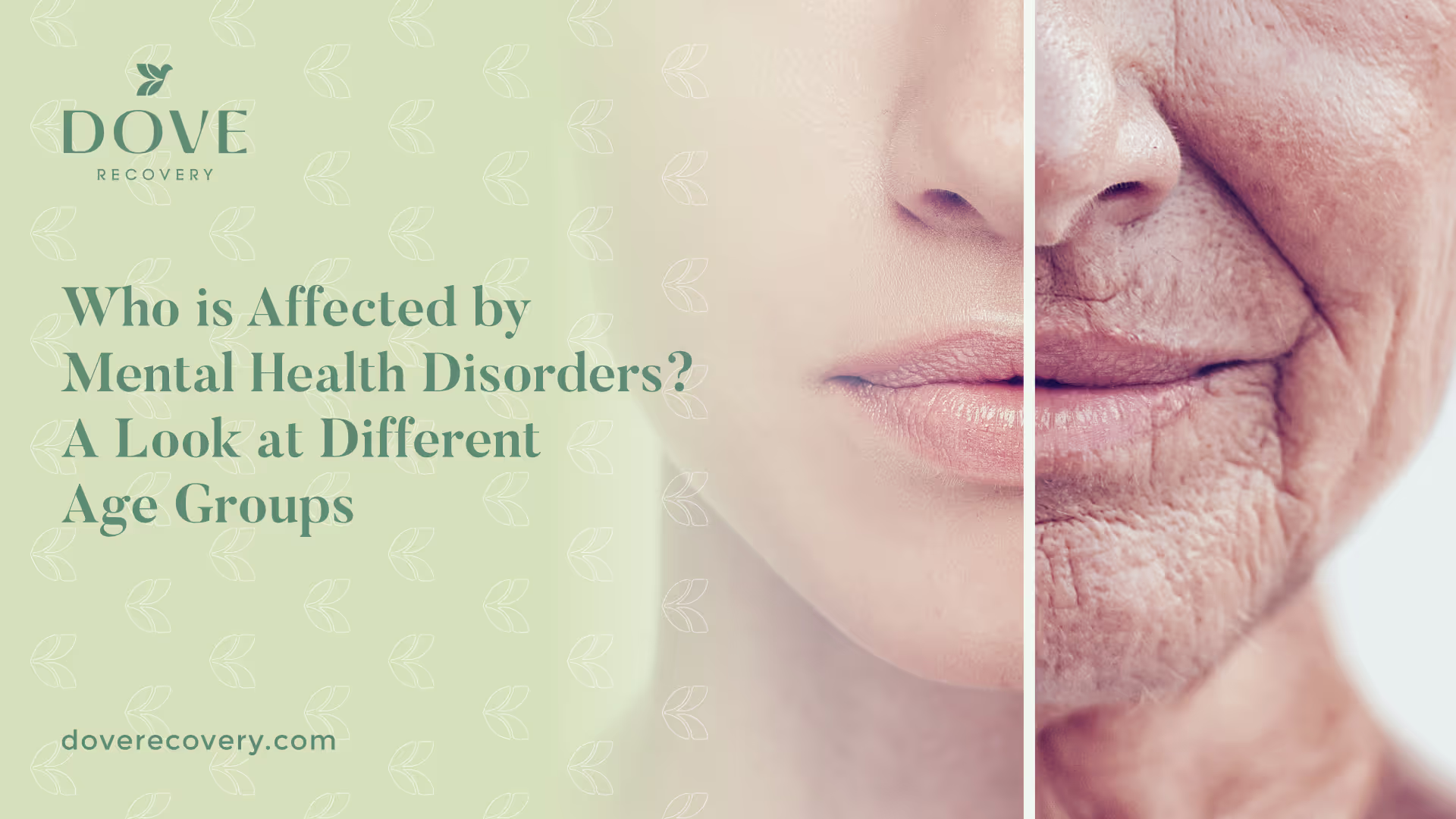90 Mental Illness & Mental Health Disorder Statistics

The latest mental health disorder statistics are staggering, and they highlight the severity of the problem. According to the National Alliance on Mental Illness (NAMI), approximately one in five adults in the United States experiences mental illness in a given year. This equates to around 51.5 million people. Moreover, one in six youth aged 6-17 experiences a mental health disorder every year.
Key Mental Health Disorder Statistics
- Mental health disorders are prevalent worldwide, affecting millions of people.
- Depression is one of the leading causes of disability globally, with over 264 million individuals affected.
- In the United States alone, around 51.5 million adults experience mental illness in a given year.
- One in six youth aged 6-17 experiences a mental health disorder every year.
How Common are Mental Health Disorders Around the World?

Mental health disorders are a global issue that affects millions of people worldwide. Here are some examples:
Depression Statistics
Depression is a common mental health disorder that affects millions of people worldwide. According to the World Health Organization (WHO), depression is the leading cause of disability worldwide. It is estimated that over 300 million people are affected by depression, which can lead to a range of symptoms including persistent sadness, loss of interest in activities, changes in appetite and sleep patterns, and thoughts of self-harm or suicide.
Depression can have a significant impact on an individual's quality of life, relationships, and ability to work or carry out daily activities.
Anxiety Disorders Statistics
Anxiety disorders are a common type of mental health condition that affect millions of people around the world. These conditions can cause excessive worry, fear, or apprehension about everyday situations, and can interfere with an individual's ability to function normally.
According to estimates, approximately 264 million people are affected by anxiety disorders globally, making them one of the most prevalent types of mental health disorders. It's important for those who are experiencing symptoms of anxiety to seek professional help and support, as these conditions can be effectively managed with therapy and/or medication.
Bipolar Disorder Statistics
Bipolar disorder is a type of mental health condition that is characterized by episodes of extreme mood swings, ranging from manic highs to depressive lows. This condition affects approximately 60 million people worldwide, and can have a significant impact on an individual's relationships, work, and daily life.
Bipolar disorder can be effectively managed with medication and therapy, but it's important for those who are experiencing symptoms to seek professional help and support.
Eating Disorders Statistics
Eating disorders such as anorexia nervosa and bulimia nervosa are serious mental health conditions that can have a significant impact on an individual's physical and emotional health. These conditions are prevalent globally, with an estimated 70 million individuals affected by anorexia nervosa or bulimia nervosa.
Eating disorders can cause a range of symptoms including severe weight loss, distorted body image, and unhealthy eating habits. They can also lead to other health complications such as heart problems, digestive issues, and mental health challenges.
Schizophrenia Statistics
Schizophrenia is a chronic mental health condition that affects millions of people around the world. This condition is characterized by symptoms such as hallucinations, delusions, disordered thinking, and social withdrawal. It can have a significant impact on an individual's ability to function in daily life.
According to estimates, approximately 20 million people are living with schizophrenia globally. While there is no cure for schizophrenia, it can be effectively managed with a combination of medication and therapy.
These are just a few examples of mental health disorders that impact populations on a global scale. It's important to prioritize mental health care and support for those who are affected by these conditions.
Prevalence of Mental Health Disorders in the United States
Mental health disorders are prevalent in the United States. Here are some key statistics:
- Anxiety disorders: This is the most common mental illness, affecting around 40 million adults in the U.S. That's about 18.1% of the population.
- Major depressive disorder: This is the second most common mental illness, affecting approximately 19.1 million adults in the U.S.
- Bipolar disorder: This condition affects approximately 2.8% of the U.S. population.
- Schizophrenia: This condition affects around 1.1% of people in the U.S.
It's important to note that these are just a few examples of mental health disorders and there are many others that affect people every day. Seeking professional help can be an important step in managing and treating these conditions.
These statistics are not just limited to the United States. In the United Kingdom, one in four people experience a mental health problem every year, while in Australia, one in five people experience mental illness. In Canada, one in five people experiences a mental health disorder in any given year, with depression being the most common.
Prevalence of Mental Health Disorders in Asia
Mental health disorders are a growing concern in Asia, where many individuals do not seek help or treatment due to fear of discrimination or shame. Here are some examples of statistics for different countries in Asia:
East Asia and the Pacific
According to a report by the Asian Development Bank, mental illness affects about 10% of the population in this region. This includes countries such as China, Japan, South Korea, and Vietnam. In China alone, it is estimated that around 173 million people suffer from mental health disorders.
India
Approximately 7.5% of the population suffers from some form of mental illness, with depression being one of the most common conditions.
Southeast Asia
A study conducted by the World Health Organization (WHO) found that anxiety disorders affect around 60 million people in this region. This includes countries such as Indonesia, Thailand, and Vietnam.
Despite these alarming statistics, there is still a lack of awareness and stigma surrounding mental health in many parts of Asia. It's important for communities and governments to prioritize mental health care and support for those who are affected by these conditions. This includes increasing awareness and education about mental health, reducing stigma, and improving access to treatment and support services.
Who is Affected by Mental Health Disorders? A Look at Different Age Groups

Mental health disorders can impact individuals of any age, from children to the elderly. According to the National Institute of Mental Health (NIMH), mental health disorders are more common among younger people. For instance, in the United States, half of all lifetime cases of mental illness begin by age 14, while three-quarters begin by age 24.
Here are some examples of mental health conditions by age group:
Children and adolescents
Attention-deficit/hyperactivity disorder (ADHD), anxiety disorders, depression, and eating disorders are some of the most common mental health conditions among this age group.
Young adults (ages 18-25)
Anxiety disorders and depression are more prevalent among this age group than any other. Substance abuse and addiction are also major concerns.
Middle-aged adults (ages 26-64)
This age group is at higher risk for stress-related disorders such as burnout and adjustment disorders. Mood disorders such as depression and bipolar disorder can also occur.
Older adults (ages 65 and above)
Late-life depression, dementia, and anxiety disorders are more common among this age group. Substance abuse and addiction can also be a concern, especially in those with chronic pain or medical conditions.
It's worth noting that mental health conditions can impact anyone at any age and should be taken seriously. Seeking professional help is crucial for early diagnosis and effective treatment.
Gender Differences in Mental Health Disorders
Mental health disorders affect people of all genders, but the prevalence and types of disorders can differ between men and women. According to the National Institute of Mental Health (NIMH), approximately 1 in 5 adults in the United States experience some form of mental illness in a given year.
Among these individuals, women are more likely than men to experience mental health disorders such as depression and anxiety. In fact, NIMH reports that women are almost twice as likely as men to be diagnosed with depression and anxiety disorders.
However, men also experience mental health disorders at significant rates. NIMH reports that approximately 6 million men in the United States experience depression each year, and one in five men develop an alcohol use disorder at some point in their lives.
Furthermore, men are more likely than women to die by suicide; the American Psychiatric Association reports that men die by suicide at a rate three times higher than that of women.
It's important for both men and women to prioritize their mental health and seek professional help when needed. By addressing mental health concerns early on, individuals can reduce the impact of these conditions on their lives and improve their overall well-being. In fact, studies have shown that access to mental health services can reduce the risk of suicide by up to 50 percent for both men and women.
Who Is At Risk From Developing a Mental Disorder?

While mental health disorders can affect anyone, certain factors may increase an individual's risk for developing a mental disorder. These risk factors include:
Family history
Individuals with a family history of mental illness may be at a higher risk for developing a mental disorder themselves.
Trauma or abuse
Traumatic events such as physical, emotional, or sexual abuse can increase an individual's risk for developing a mental health disorder.
Chronic medical conditions
Certain chronic medical conditions such as cancer, heart disease, and chronic pain can increase the likelihood of developing depression or anxiety.
Substance use
Substance abuse and addiction can contribute to the development of mental health disorders such as depression and anxiety.
Environmental factors
Factors such as poverty, homelessness, and exposure to toxins or pollutants can also increase an individual's risk for developing a mental disorder.
It's important to note that while these factors may increase an individual's risk for developing a mental disorder, they do not necessarily guarantee that someone will develop one. Seeking professional help and support can be crucial in managing these risks and preventing the onset of a mental health condition.
Health Systems and Social Support
Access to healthcare and social support are important factors in managing mental health conditions. Unfortunately, many individuals around the world lack access to these resources.
According to the World Health Organization (WHO), only 1 in 27 people with mental health disorders in low- and middle-income countries receive adequate treatment. In high-income countries, this number is only slightly better at 1 in 5 people receiving appropriate care.
Furthermore, a lack of social support can exacerbate mental health conditions and contribute to feelings of isolation and loneliness. A study by Cigna found that nearly half of Americans report feeling alone or left out, with younger generations being especially affected.
It's important for governments and healthcare systems to prioritize mental health care and support services, as well as increasing access to these resources for those who need them. Additionally, building strong social connections and support networks can be crucial in managing mental health conditions.
Conclusion
Mental health is a crucial aspect of overall well-being that is often overlooked. It is estimated that one in four people globally will be affected by mental or neurological disorders at some point in their lives. The World Health Organization (WHO) reports that depression is one of the leading causes of disability worldwide, affecting over 264 million people.
Mental health disorders are a global challenge that affect millions of people from all walks of life. While the prevalence and types of disorders may differ between countries, age groups, and genders, it is clear that mental health is an issue that affects us all.
It's important to prioritize mental health care and support, reduce stigma and discrimination, increase awareness and education about mental health, and improve access to treatment and support services.
By doing so, we can help those who are affected by these conditions live healthy, fulfilling lives. Remember: seeking professional help for mental health concerns can be an important step in managing and treating these conditions.
Sources:
- National Alliance on Mental Illness: https://www.nami.org/mhstats
- World Health Organization: https://www.who.int/mental_health/management/en/mhdsws1.pdf
- Centers for Disease Control and Prevention: https://www.cdc.gov/mmwr/volumes/69/wr/mm6932a1.htm
- Kaiser Family Foundation: https://www.kff.org/coronavirus-covid-19/issue-brief/the-implications-of-covid-19-for-mental-health-and-substance-use/
- Thriving Guide: https://thrivingguide.com/2023/08/22/ketamine-depression-unlocking-new-avenues-of-hope/
